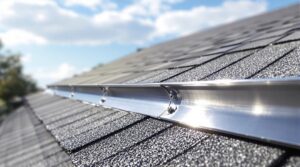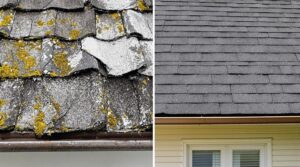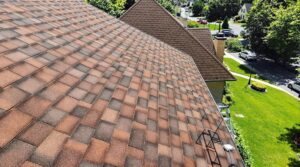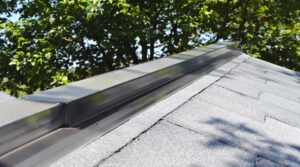Wondering how to tackle that new roof without breaking the bank? Let's explore your wallet-friendly options! Think of your roof investment like planning a dream vacation – you've got multiple ways to make it happen.
First up, the straightforward cash route. Just like buying a car outright, paying cash for your roof means no pesky interest charges nipping at your heels. But let's be real – not everyone has a small fortune stashed under their mattress.
That's where financing swoops in to save the day. You've got choices ranging from personal loans to credit cards and home equity options. Interest rates typically dance between 3% and 20%, depending on your credit score and which path you choose. It's like having a financial buffet – pick what works best for your situation!
Here's a game-changer: your insurance might be your golden ticket. If Mother Nature hasn't been kind to your roof, your policy could cover the whole shebang. Pro tip: bringing a public adjuster into the mix can boost your chances of a successful claim by 747%. They're like your personal roof-funding detective, uncovering every possible penny from your policy.
Remember, choosing how to fund your new roof isn't just about picking a payment method – it's about finding a solution that keeps both your home and your finances weatherproof for years to come. What's your preferred way to invest in your home's crown?
Key Takeaways
Need a New Roof But Worried About the Cost? Let's Talk Options!
Think of your roof as an investment portfolio – you've got multiple ways to fund it, each with its own perks and quirks:
Cash Is King 🏆
Paying upfront puts you in the driver's seat! You'll often score sweet contractor discounts and dodge those pesky interest charges. Plus, who doesn't love a good bargaining position?
Tap Into Your Home's Value 🏠
Home equity loans and HELOCs are like borrowing from your house's piggy bank. With rock-bottom interest rates and tax-deductible interest, they're often your smartest financing buddy.
Let Insurance Have Your Back ☂️
Storm damage? Hail horror? Your insurance might foot the entire bill! Just make sure the damage matches your policy's covered events – it's like having a safety net for your home's crown.
Quick-but-Costly Options 💳
Personal loans and credit cards are your fast-track options. They're like convenience stores – quick and easy, but you'll pay premium prices through higher interest rates.
Hidden Gems 💎
Don't overlook government programs and manufacturer financing! Think of these as secret passages to affordability – especially if you meet specific requirements. They're like finding money in your old jacket pocket!
Remember: your perfect roofing payment plan is as unique as your home. What works for your neighbor might not work for you, so choose wisely!
Understanding Your Roof Replacement Budget
Understanding the financial scope of a roof replacement requires careful consideration of multiple cost factors.
Material selection forms the foundation of budget planning, with options ranging from economical asphalt shingles to premium tile roofing. Labor typically constitutes 40-60% of total expenses, varying based on roof complexity and seasonal timing.
Effective expense tracking must account for essential administrative requirements, including permits and inspections mandated by local building codes.
Additional components like underlayment and insulation, while increasing initial costs, contribute to long-term savings.
Regional factors, including climate considerations and local regulations, further influence the overall budget.
Winter and early spring installations often present opportunities for cost reduction through decreased demand and accelerated completion times, making timing an important consideration in budget optimization.
Working with a public adjuster can increase insurance settlement amounts by 50% or more for qualifying roof replacement claims.
The Benefits of Paying With Cash

While financing options abound for roof replacement projects, paying with cash offers distinct financial and logistical advantages. Cash payments eliminate interest charges and loan fees, reducing the overall project cost. Additionally, homeowners can bypass credit checks and loan approval delays, enabling quicker project initiation. Regular roof maintenance and upkeep can help homeowners secure lower insurance premiums over time.
| Cash Payment Advantages | Important Considerations |
|---|---|
| No Interest Charges | Verify Contractor Trustworthiness |
| Immediate Project Start | Confirm Written Contracts |
| Negotiation Power | Document All Transactions |
| Lower Total Cost | Maintain Proof of Payment |
However, cash transactions require careful consideration of contractor trustworthiness. Homeowners should thoroughly vet contractors, obtain written agreements, and maintain proper documentation to protect their investment. This approach also provides greater flexibility in material selection and timeline management, while potentially reducing administrative costs associated with insurance claims or financing paperwork.
Insurance Coverage for Roof Replacements

When disaster strikes a home's roof, insurance coverage can provide essential financial protection for replacement costs. Understanding the type of coverage is vital: Replacement Cost Value (RCV) policies cover the full cost of a new roof, while Actual Cash Value (ACV) policies only pay for the depreciated value, considering age and condition.
To initiate the claim process, homeowners must document damage with photos, review their insurance policy for covered perils, and contact their insurer for inspection.
While wind, hail, and fire damage are typically covered, policies exclude wear and tear, flooding, and neglect. Insurance companies require detailed documentation, including repair estimates and emergency repair receipts.
Claims adjusters assess the damage, and reimbursement is provided up to policy limits after the deductible is met. Hiring a public adjuster can lead to settlements that are 574% higher compared to self-filing claims.
Popular Financing Options Available

Several practical financing options exist for homeowners needing a new roof, including personal loans that offer fixed terms and competitive interest rates compared to credit cards.
Credit cards, while carrying higher interest rates, provide immediate access to funds for urgent roof repairs and may offer promotional zero-interest periods.
Home equity financing options like HELOCs and home equity loans typically feature the lowest interest rates by using the home as collateral, though they require sufficient equity and strong credit scores to qualify.
Having an adequate emergency fund is essential when choosing higher deductibles for your homeowners insurance policy that could help cover roof replacement costs.
Personal Loan Benefits
Personal loans represent one of the most accessible financing options for homeowners seeking to fund a new roof installation.
These loans offer several key personal loan advantages, including competitive interest rates ranging from 7.5% to 36% APR, depending on credit score, and quick access to funds within one to seven days of approval.
The loan repayment options provide flexibility with terms spanning two to seven years, allowing homeowners to structure manageable monthly payments.
Borrowers with good credit scores of 690 or higher typically qualify for lower rates and larger loan amounts.
Unlike home equity loans, personal loans require no collateral, eliminating the risk of losing one's home.
Additionally, the streamlined application process often results in quick approvals, making personal loans an efficient choice for urgent roofing projects.
Credit Card Payment Options
Homeowners contemplating credit card financing for a new roof should carefully evaluate the various payment options available through major credit card issuers.
While credit card rewards can offset some costs, high interest rates may greatly increase the total expense unless managed strategically.
Key factors to weigh when using credit cards for roof financing include:
- 0% introductory interest rates, typically lasting up to 12 months
- Credit limits that may restrict financing options, usually capped at $10,000
- Transaction fees ranging from 3-5% of the total cost
- Potential impact on credit scores due to high utilization rates
For best results, homeowners should focus on cards offering extended 0% interest periods and substantial rewards programs, while having a clear repayment strategy to avoid costly long-term debt accumulation.
Home Equity Financing
Beyond credit card options, home equity financing presents a robust pathway for funding a new roof through three main vehicles: home equity loans, home equity lines of credit (HELOCs), and cash-out refinancing.
Each loan option leverages existing home equity differently. Home equity loans provide fixed-rate borrowing up to 85% of home value minus mortgage balance, offering predictable payments but requiring a lengthy approval process.
HELOCs function as revolving credit lines with variable rates, providing flexibility but carrying overspending risks.
Cash-out refinancing replaces the existing mortgage with a larger one, delivering substantial funds but increasing monthly payments and long-term costs.
While these options typically offer lower interest rates than traditional financing, they all require strong credit, steady income, and sufficient equity.
Defaulting on payments risks home foreclosure.
Regular maintenance and professional appraisals help determine accurate home values for equity-based financing qualification.
Breaking Down Roof Replacement Costs

Roof replacement costs vary considerably based on several key factors, including square footage, material selection, geographic location, and additional project requirements.
A thorough roof cost analysis reveals that homeowners can expect to pay between $4,500 to $10,000 per thousand square feet, with total costs scaling based on home size.
Key cost factors include:
- Square footage, with 1,000 sq ft homes averaging $4,500-$11,000
- Material selection, ranging from basic asphalt ($5,800) to premium slate ($30,000)
- Geographic location, with costs varying from $5,900 in Florida to $19,400 in New York
- Additional expenses like steep slopes ($1,000-$3,000), permits, and disposal fees
Material price comparison shows significant variation, with asphalt shingles being the most economical choice while stone, slate, and wood shake command premium prices due to their durability and aesthetic appeal.
Professional roofers must maintain safety gear requirements including harnesses, specialized footwear, and fall protection systems that collectively add $1,700-4,400 per worker to overall project costs.
Key Factors That Impact Your Total Cost
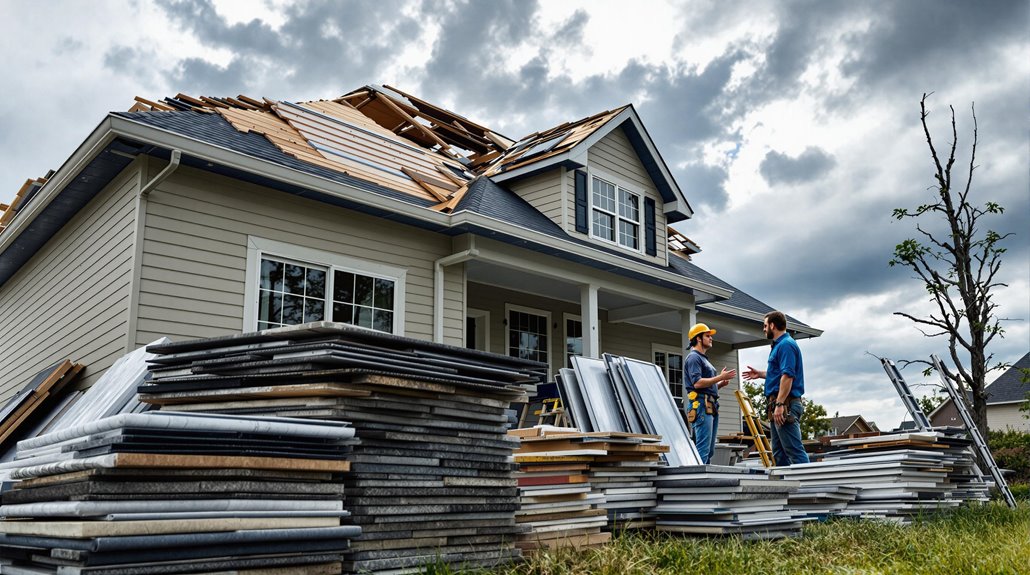
Understanding the total cost of a new roof requires careful analysis of multiple interrelated factors that collectively determine the final investment.
Material selection serves as a primary cost driver, with prices ranging from $120 for asphalt shingles to $1,500 for metal roofing per 100 square feet. Labor costs fluctuate based on roof complexity, pitch, and accessibility.
Structural elements like size, design intricacy, and special features such as skylights or chimneys directly impact expenses.
Regional factors, including permit fees, building codes, and environmental conditions, can greatly influence overall costs.
Additional considerations encompass waste disposal fees, potential water damage repairs, and insurance coverage options.
The combination of these variables creates a unique cost profile for each roofing project, making detailed assessment essential for accurate budgeting.
Insurance claims for covered peril damage typically require thorough documentation of weather impacts and material deterioration before any repairs can begin.
Hidden Expenses to Consider

Homeowners should factor in permit and inspection fees that typically range from $150 to $500 for roofing projects, with additional costs varying considerably by location and project scope.
Material transport charges can increase the total cost, particularly when roof accessibility is challenging or special equipment is required for loading shingles.
Understanding these hidden expenses early in the planning process allows homeowners to allocate 20-30% of their budget for such additional costs and avoid financial surprises during the project.
Working with public adjusters can increase insurance claim settlements by 20-50% to help offset these unexpected costs.
Permits and Local Fees
The complex world of building permits and local fees represents a considerable yet often overlooked expense in roof replacement projects. The permit application process varies considerably by location, with costs ranging from $250 to $500 for standard roofing permits, plus additional charges for roofs exceeding 1,000 square feet. Local building regulations dictate specific requirements, impacting overall project costs.
Key factors affecting permit expenses include:
- Geographic location, with fees varying dramatically between cities (e.g., Los Angeles: $640-$4,080; New York: $560-$3,520)
- Project scope and complexity, particularly for multi-family units
- Material choices and roof design specifications
- Required inspections and compliance verifications
Homeowners should factor these permit costs into their budget planning, as they represent a mandatory expense that contractors may include in their total project quote or charge separately for processing.
Material Transport Charges
While roofing estimates often highlight primary material and labor costs, material transport charges represent a significant yet frequently overlooked expense in roof replacement projects. These charges encompass delivery of materials and equipment to and from the job site, with costs varying based on multiple factors.
| Factor | Impact | Budget Considerations |
|---|---|---|
| Distance | Higher costs for remote locations | Add 5-15% buffer |
| Material Type | Specialty items cost more to transport | Research supplier locations |
| Project Size | Larger projects require multiple deliveries | Calculate per-trip costs |
To avoid budget surprises, homeowners should request detailed transport cost breakdowns upfront and factor these expenses into their overall project budget. Material transport costs can add hundreds or thousands to the final bill, making it essential to understand these charges during the planning phase.
Working With Insurance Claims
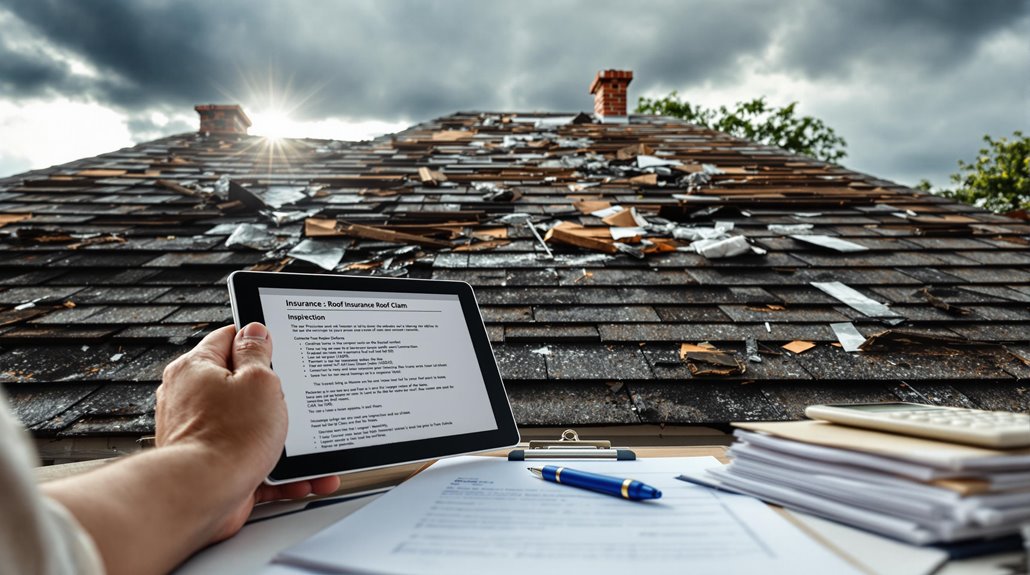
Maneuvering insurance claims for roof replacement requires a methodical approach to maximize reimbursement potential.
Insurance claim tips emphasize thorough damage documentation through photos and detailed descriptions before initiating the claims process. A systematic approach involves policy review, professional inspections, and strategic communication with adjusters.
Working with public insurance adjusters can increase settlement amounts by 30-50% compared to filing independently.
Key steps for successful claims include:
- Document all damage immediately with clear photos and videos
- Review policy coverage and understand deductible requirements
- Schedule independent contractor inspection before filing
- Maintain detailed records of all communications with insurers
After inspection, the insurance company determines claim value and issues payment, often requiring mortgage lender endorsement.
If a claim is denied, homeowners can dispute the decision by submitting additional documentation or seeking legal counsel for complex cases.
Choosing the Right Payment Method

When selecting a payment method for a new roof, homeowners must evaluate their financial position against available options including cash, loans, and credit-based financing.
Personal factors such as credit score, home equity, and monthly budget constraints will determine which payment routes are most viable and cost-effective.
A thorough comparison of interest rates, repayment terms, and total costs across different payment methods enables homeowners to make an informed decision that aligns with their financial goals.
Upgrading roof conditions through proper maintenance and repairs may help secure reduced insurance premiums over time while protecting the home from damage. Regular inspections and timely repairs can extend the lifespan of your roof, ensuring that it remains in optimal condition and minimizes the risk of leaks or structural damage. Furthermore, understanding the intricacies of your policy can shed light on how maintaining your roof can affect costs, particularly when it comes to roof replacement insurance explained. By being proactive and informed, homeowners can not only safeguard their property but also potentially save money on their insurance premiums.
Compare Payment Options
Since investing in a new roof represents a considerable financial commitment, homeowners should carefully evaluate their payment options to select the most cost-effective solution.
Each payment method offers distinct advantages for budget planning and payment flexibility:
- Cash payments eliminate interest charges and simplify the process but require substantial upfront capital.
- Home equity options like HELOCs and cash-out refinancing leverage existing home value with competitive rates.
- Personal financing through credit cards or loans provides quick access to funds but typically carries higher interest.
- Insurance coverage and government programs may offset costs considerably for qualifying homeowners.
Understanding these options enables informed decisions based on individual circumstances, credit scores, and home equity position.
Factors such as interest rates, repayment terms, and qualification requirements should guide the selection process.
Know Your Financial Situation
Before selecting a payment method for a new roof, homeowners must conduct a thorough assessment of their financial position. This involves a detailed budget analysis that evaluates current savings, income stability, and existing debt obligations.
Key considerations include available emergency funds, credit score status, and monthly disposable income.
Financial forecasting plays an essential role in determining the most suitable payment approach. Homeowners should calculate how different payment methods might impact their long-term financial goals and monthly cash flow.
This assessment should account for potential changes in income, upcoming major expenses, and the property's overall financial health. Understanding these factors helps determine whether immediate cash payment, financing options, or a combination approach best aligns with the homeowner's financial circumstances while maintaining stable household finances.
Tips for Managing Roof Replacement Expenses

Managing roof replacement expenses requires careful planning and strategic decision-making to optimize both short-term costs and long-term value.
Cost saving strategies include obtaining multiple quotes from contractors, researching material options, and scheduling work during off-peak seasons.
Effective budgeting tips emphasize the importance of understanding total project costs, including labor, materials, permits, and potential contingencies.
Key actions for expense management:
- Compare quotes from at least three reputable contractors
- Research material costs and durability ratings to balance initial investment with longevity
- Consider overlay options when appropriate to reduce labor and material expenses
- Schedule installation during off-season periods to leverage contractor discounts
Understanding local market conditions, building codes, and additional component requirements guarantees accurate budget planning and prevents unexpected cost overruns.
The Benefits Of Consulting A Public Adjuster
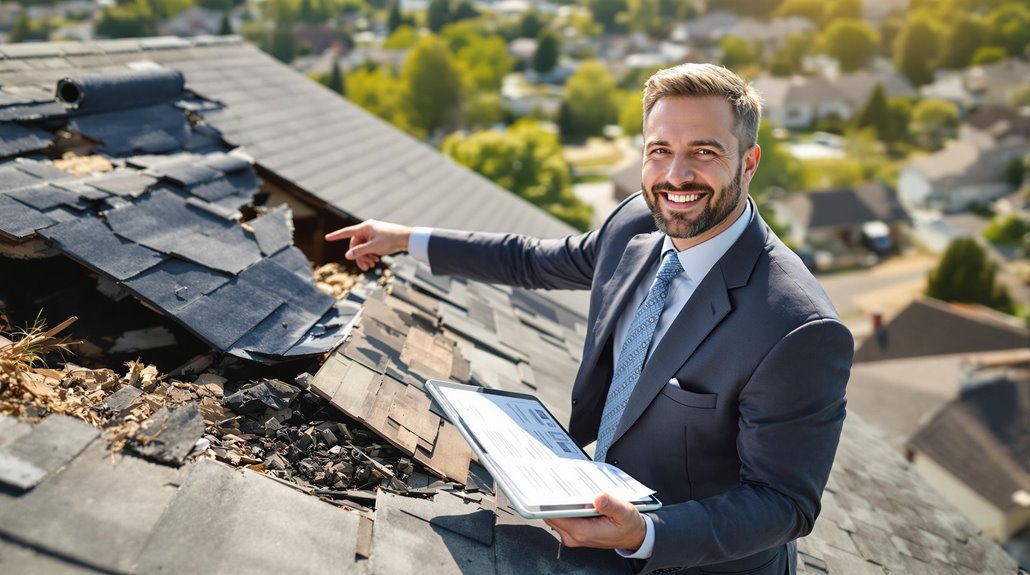
Consulting a public adjuster can greatly enhance the roof insurance claim process through their expertise in policy interpretation and proven track record of securing higher settlements.
Public adjusters provide objective damage assessments backed by thorough documentation and expert opinions, which strengthens the homeowner's position during negotiations with insurance companies.
Their professional management of the claims process typically results in more extensive coverage and faster claim resolution, while eliminating common pitfalls that often reduce claim payouts.
Expertise In Insurance Claims
When dealing with roof insurance claims, homeowners can greatly improve their chances of a favorable settlement by engaging a public adjuster. These professionals possess extensive expertise in policy interpretation and can considerably strengthen a claim appeal through their thorough understanding of insurance procedures.
Key advantages of working with public adjusters include:
- In-depth analysis of policy terms to identify all available coverage benefits
- Professional documentation of damage assessments and repair estimates
- Strategic negotiation with insurance companies to maximize settlements
- Expert guidance through complex claims procedures and deadlines
Public adjusters typically work on a contingency basis, meaning they only receive payment after successfully settling the claim.
Their expertise often results in higher settlement amounts that can offset their fees while ensuring homeowners receive fair compensation for roof repairs.
Objective Damage Assessment
Public adjusters provide essential objectivity in roof damage assessments, ensuring that every aspect of the damage is thoroughly documented and properly valued.
Their professional assessment techniques include extensive interior and exterior inspections, detailed photographic evidence, and multiple repair estimates to accurately determine costs.
These experts excel in damage documentation, collecting vital supporting materials such as repair receipts and maintenance records while categorizing findings by affected areas.
Their thorough evaluation process helps identify the precise cause of damage, whether from hail, wind, or water infiltration.
This systematic approach enables them to differentiate between damages requiring repair versus replacement, supporting stronger insurance claims.
Streamlined Claim Process
Building upon objective damage assessments, the streamlined approach of a public adjuster greatly reduces claim processing time while maximizing settlement outcomes.
These licensed professionals understand complex policy interpretation and navigate insurance bureaucracy efficiently, serving as dedicated advocates throughout the claim process.
- Expert documentation and thorough damage assessments strengthen the validity of claims
- Professional negotiation with insurance carriers often results in higher settlement amounts
- Specialized knowledge of roofing materials and repair costs guarantees accurate valuations
- Complex policy terms are interpreted to maximize coverage benefits
While public adjusters charge a percentage of the settlement, their expertise often leads to considerably higher payouts that offset their fees.
Their thorough understanding of insurance procedures and ability to overturn denied claims makes them valuable partners in securing fair compensation for roof damage.
Higher Claim Payouts & Settlements
Statistics consistently show that policyholders who engage public adjusters receive notably higher claim settlements compared to those who handle claims independently. Through expert claim negotiation strategies and thorough damage documentation, public adjusters leverage their specialized knowledge to maximize insurance payouts.
| Benefit | Impact | Outcome |
|---|---|---|
| Expert Assessment | Detailed damage evaluation | Complete cost capture |
| Professional Negotiation | Counter insurer tactics | Higher settlements |
| Documentation Management | Organized claim presentation | Faster processing |
Their contingency-based fee structure, typically up to 10% of the settlement, aligns with the adjuster's motivation to secure ideal compensation. This arrangement often results in net settlements considerably higher than self-managed claims, even after accounting for the adjuster's fees, making their services a financially sound investment for substantial roof damage claims.
About The Public Claims Adjusters Network (PCAN)
A nationwide coalition of independent insurance advocates, the Public Claims Adjusters Network (PCAN) represents professionals who help property owners navigate complex insurance claims processes.
These certified experts leverage their collective knowledge to maximize insurance settlements while adhering to state-specific regulations and fee structures.
Key advantages of working with PCAN members include:
- Independent representation throughout the claims adjustment process
- Expert damage assessment and accurate repair cost evaluations
- Professional negotiation with insurance carriers
- Extensive documentation and paperwork management
PCAN members typically charge between 10-20% of the settlement amount, with specific caps varying by state.
For example, Florida limits fees to 20% for standard claims and 10% during state emergencies, ensuring fair compensation while protecting policyholder interests.
Frequently Asked Questions
Can I Negotiate the Price of a New Roof With Contractors?
Roofing negotiations with contractors are possible and common practice. Obtaining multiple quotes, comparing market rates, and discussing bulk material pricing can lead to competitive contractor pricing adjustments.
How Long Does Roof Financing Approval Typically Take?
Time is of the essence with roof financing. The loan application process varies considerably, with approval timelines ranging from same-day decisions to four weeks, depending on the financing type selected.
Will Getting a New Roof Increase My Home's Resale Value?
A new roof typically increases home resale value by 60-70% of installation costs, with asphalt shingles offering 68.2% ROI and metal roofs providing 60.9% value increase.
Should I Get Multiple Roofing Estimates Before Choosing Payment Options?
Obtaining multiple roofing estimates enables homeowners to compare pricing structures, evaluate contractor reliability, and determine ideal payment options. This research typically leads to better financial decisions and project outcomes.
Are There Tax Deductions Available for Roof Replacement Costs?
Tax benefits for roof upgrades vary by property type. Residential replacements generally aren't deductible, while commercial properties can claim Section 179 deductions. Energy-efficient roofs may qualify for federal tax credits.
References
- https://www.angi.com/articles/how-much-does-roof-replacement-cost.htm
- https://myroofhub.com/pricing/roof-payment-financing-options/
- https://hhhroofing.com/how-to-pay-for-a-new-roof/
- https://theroofdoctors.net/roofing-costs-in-california-the-cost-of-a-new-roof/
- https://newviewroofing.com/blog/roofing/pros-and-cons-of-paying-for-a-roof-replacement-in-cash/
- https://hightightroofing.com/blog/7-factors-that-affect-roof-replacement-costs/
- https://roofsimple.com/will-roofing-companies-finance/
- https://nuhomeonline.com/what-factors-go-into-roof-replacement-costs/
- https://www.iko.com/blog/financing-your-roof-replacement-or-repair/
- https://www.tangoandgatti.com/roofing/benefits-and-risks-of-using-cash-to-fund-a-roofing-project/

